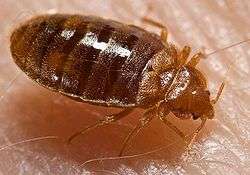Cimicidae
| Bed bug | |
|---|---|
 | |
| Cimex lectularius | |
| Scientific classification | |
| Kingdom: | Animalia |
| Phylum: | Arthropoda |
| Class: | Insecta |
| Order: | Hemiptera |
| Superfamily: | Cimicoidea |
| Family: | Cimicidae Latreille, 1802 |
| Subfamilies, Genera & Species | |
|
Subfamily Afrociminae
Subfamily Cimicinae
Subfamily Cacodminae
Subfamily Haematosiphoninae
Subfamily Latrocimicinae
Subfamily Primicimicinae
| |
The Cimicidae are a family of small parasitic insects that feed exclusively on the blood of warm-blooded animals. They are called cimicids or, loosely, bed bugs (or bedbugs or bed-bugs), though the latter term properly refers to the most famous species of the family, Cimex lectularius, the common bed bug. Around 90 species are placed in the family Cimicidae.[2]
Biology
All cimicids are small, oval-shaped, and flat in appearance, although their bodies bulge after feeding. They do not fly, but do have small, nonfunctional wing pads. They also have beak-like mouth parts with which they pierce the skin and suck the blood of their hosts.[3]
Cimicids practice traumatic insemination. Although the female has a normal genital tract for laying eggs, the male never uses it (except in the species Primicimex cavernis), instead piercing the female's abdominal wall; the sperm then migrate through the female's paragenital system.
Feeding is required for egg production in females and possibly for sperm production in males. Egg-laying behavior varies among species. C. lectularius stops laying fertile eggs about 35 to 50 days after the last insemination. The swallow bug, Oeciacus vicarius, hibernates after mating in autumn and begins laying in spring, to coincide with the return of the host.
The five nymphal instars (stages) must each take a blood meal to develop to the next stage. Adults have been reported to live 3-12 months in an untreated household situation. A given undisturbed bug may take 3-15 minutes to take a full meal depending on its life stage. They can survive long periods of time without feeding, reappearing from their hiding places when hosts again become available. They have special scent glands and often emit a characteristic odor that can usually be detected in heavily infested sites. Dark fecal spots on bedding or bedclothes, pearly white eggs (1 mm long), and papery yellowish cast “skins” are other signs of infestation often found in cracks or crevices.
Cimicidae are easily repelled by lavender, mint, and an excessive heat.
Hosts
Cimicids are relatively specialized in their choice of hosts, compared to other bloodsucking insects. Most cimicids have a preferred host, but accept some others when presented with the choice, such as C. lectularius and C. hemipterus, which are most often found among humans, but can also survive by feeding on birds, bats, rabbits, and mice. Some subfamilies are restricted to certain types of bats, while one species, P. cavernis, appears to accept only one species of host.
Host switching is dependent on several factors, including overlap in host detection cues and ability to digest different kinds of blood. For example, the red blood cells of chickens are about 3 to 5 μm longer in diameter than those of humans, making human blood more suitable for the narrow food canal of C. lectularius. C. hemipterus may be able to vary the size of its food canal, allowing it greater flexibility in its choice of hosts. Preference for a host species can vary between populations of a given species; the causes for this are unclear.
Behavior
Cimicids are attracted to hosts by a variety of cues, including heat (even a temperature difference of 1°C) and kairomones. Host cues (at least in some species, including C. lectularius and Stricticimex antennatus) change from attractants to repellants after a cimicid has fed, causing it to move out of a danger zone after feeding.
Most cimicids feed once every 3 to 7 days in natural conditions. C. lectularius normally feeds once every 7 days and Ornithocoris toledoi every 8 days, though C. hemipterus has been observed feeding every day for several days (in hot climates). Excessively hot or cold temperatures disrupt normal behavior.
Transmission of pathogens
Although viruses and other pathogens can be transmitted to cimicids, they rarely transmit them to their hosts. O. vicarius is a vector of several arboviruses, but is not killed by these viruses. Trypanosoma cruzi, the trypanosome that causes Chagas disease, is rarely transmitted from cimicids to bats, but it has not been observed replicating after such transmission. The viruses HIV and hepatitis B can persist in C. lectularius for two weeks, but with no viral replication. The possibility of these and most other viruses being transmitted from C. lectularius to humans is considered extremely remote.[4][5][6]
References
- ↑ [No authors listed] (1996). "Oeciacus hirundinis (Lamarck, 1816)". Integrated Taxonomic Information System. Retrieved 2010-09-15.
- ↑ "Bed Bugs - Cimicidae - Overview - Encyclopedia of Life". Encyclopedia of Life. Retrieved 3 September 2016.
- ↑ Jones, Susan C.; Kyle K. Jordan. "Bat Bugs". Ohio State University Extension Fact Sheet. Ohio State University. Retrieved 2007-09-22.
- ↑ Reinhardt, Klaus; Siva-Jothy, Michael T. (Jan 2007). "Biology of the Bed Bugs (Cimicidae)" (PDF). Annual Review of Entomology. 52: 351–374. doi:10.1146/annurev.ento.52.040306.133913. PMID 16968204. Retrieved 26 May 2010.
- ↑ "What Are Bed Bugs? How To Kill Bed Bugs". Medical News Today. MediLexicon International Ltd. 20 Jul 2009. Retrieved May 27, 2010.
- ↑ Goddard J, deShazo R (April 2009). "Bed bugs (Cimex lectularius) and clinical consequences of their bites". JAMA. 301 (13): 1358–66. doi:10.1001/jama.2009.405. PMID 19336711.